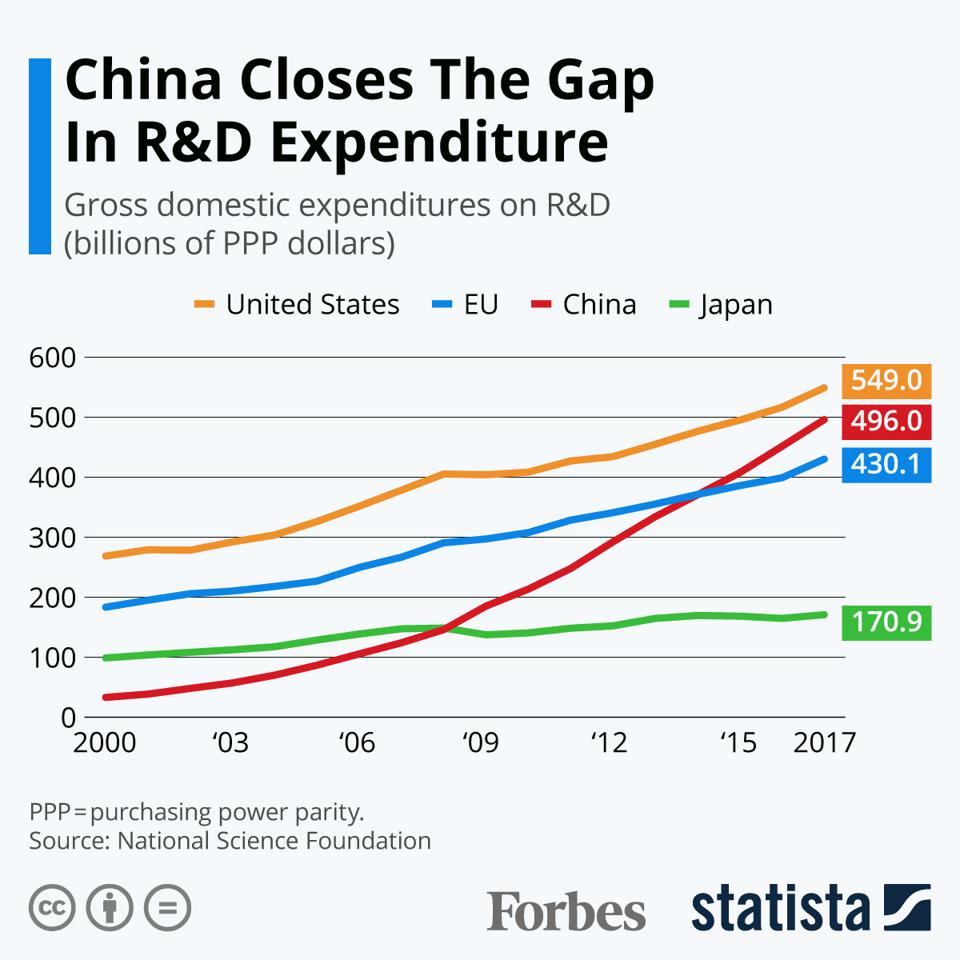beijingwalker
ELITE MEMBER

- Joined
- Nov 4, 2011
- Messages
- 65,195
- Reaction score
- -55
- Country
- Location
China Is Closing The Gap With The U.S. In R&D Expenditure [Infographic]
Jan 20, 2020, 06:57am
For years, the United States has remained the undisputed leader in funding for scientific research and development with investment growing at an average of 4.3% per year from 2000 to 2017.
China is making steady progress at closing the innovation gap, however, with R&D spending growing by more than 17% each year during the same period. That's according to the latest edition of the U.S. National Science Foundation's (NSF) biennial Science and Engineering Indicators report which found that total global R&D expenditure expanded threefold between 2000 and 2017, rising from $722 billion to $2.2 trillion.
In 2017, total U.S. spending on R&D added up to $549 billion (PPP), while China came a not too distant second with $496 billion. Globally, the U.S. and China accounted for nearly half of the world's global R&D total in 2017 at 25% and 23% respectively.
China's rapid progress can be seen by its spending levels at the turn of the century when R&D expenditure only totalled $33 billion while U.S. investment came to $269 billion.
Even though the U.S. is the world's top domestic R&D spender, the NSF states that several smaller economies boast a greater "R&D intensity" which means they have a higher ratio of R&D expenditures to GDP. South Korea had the highest ratio at 4.6% in 2017 followed by Japan and Germany with 3.2% and 3% respectively.
The ratio in the U.S. stood at 2.8% that year while China's was 2.2%. In the U.S., the business sector was the leading source of R&D funding in 2017 at 70%, followed by the federal government at 10%.

https://www.forbes.com/sites/niallm...s-in-rd-expenditure-infographic/#2e7004045832
Jan 20, 2020, 06:57am
For years, the United States has remained the undisputed leader in funding for scientific research and development with investment growing at an average of 4.3% per year from 2000 to 2017.
China is making steady progress at closing the innovation gap, however, with R&D spending growing by more than 17% each year during the same period. That's according to the latest edition of the U.S. National Science Foundation's (NSF) biennial Science and Engineering Indicators report which found that total global R&D expenditure expanded threefold between 2000 and 2017, rising from $722 billion to $2.2 trillion.
In 2017, total U.S. spending on R&D added up to $549 billion (PPP), while China came a not too distant second with $496 billion. Globally, the U.S. and China accounted for nearly half of the world's global R&D total in 2017 at 25% and 23% respectively.
China's rapid progress can be seen by its spending levels at the turn of the century when R&D expenditure only totalled $33 billion while U.S. investment came to $269 billion.
Even though the U.S. is the world's top domestic R&D spender, the NSF states that several smaller economies boast a greater "R&D intensity" which means they have a higher ratio of R&D expenditures to GDP. South Korea had the highest ratio at 4.6% in 2017 followed by Japan and Germany with 3.2% and 3% respectively.
The ratio in the U.S. stood at 2.8% that year while China's was 2.2%. In the U.S., the business sector was the leading source of R&D funding in 2017 at 70%, followed by the federal government at 10%.

https://www.forbes.com/sites/niallm...s-in-rd-expenditure-infographic/#2e7004045832



